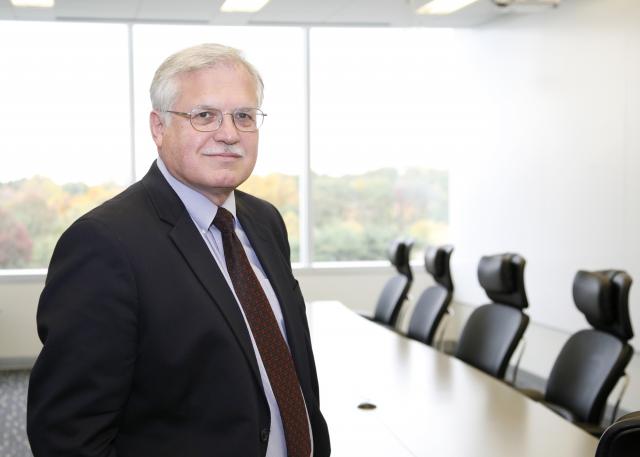Q&A: Kean Scientist Helps Lead International Race for New Antibiotics

Keith Bostian, Ph.D., dean of the New Jersey Center for Science, Technology and Mathematics.
Keith Bostian, Ph.D., dean of the New Jersey Center for Science, Technology and Mathematics, is one of the leading scientists in the world researching drug-resistant antibiotics. He will be in Berlin this week, meeting with the international organization CARB-X (Combating Antibiotic Resistant Bacteria) to discuss how the Institute for Life Science Entrepreneurship at Kean University (ILSE) can help advance its mission of identifying and developing new antibiotics to fight superbugs that are no longer responding to existing drugs.
University Relations sat down with Dean Bostian for a brief interview on the drug-resistant antibiotic crisis and Kean’s involvement in this area of research.
What is the status of the drug-resistant antibiotic threat?
Multidrug resistance is becoming a significant worldwide threat and global health crisis. Right now in the United States, about 2 million people each year get a multidrug resistant infection and 23,000 people die from those infections. It is projected that by 2050, there will be 50 million deaths in the world from multidrug resistant bacteria. So this problem has systematically gotten worse over the years. It has gotten to a tipping point now where most of the major drug classes have significant resistant problems.
There are a lot of strategies that are being developed in the private sector, public sector, and across the world to combat this, but the fundamental problem is resistance will always continue and new antibiotics will always be needed.
What are the obstacles?
It's getting harder to find new ways to target bacteria to be killed. Once we identify a path and perform the clinical research and get a drug to the market, there is a reluctance to use these drugs in order to preserve them to block future resistance. The less you use the antibiotic, in general, the longer the utility it will have against resistant organisms.
The drugs are back-shelved and held in reserve, and that reduces the commercial prospects and the attractiveness to a company investing the tens of millions of dollars needed to develop the antibiotic.
How crucial is it to develop new antibiotics?
A lot of the modern medical advances – hip replacement, cancer therapies, treatment of some chronic diseases – all depend on antibiotics to work. You can cure your cancer, but if you get an infection due to immunosuppression, you could die if it is a multidrug resistant bacteria.
What is being done about it?
A lot of organizations around the world are trying to address this problem. CARB-X and several other organizations are providing grants to fund early, discovery-stage research. There are also a number of proposals in Congress to provide incentives to companies to develop antibiotics.
The FDA has gone a tremendous distance toward streamlining the clinical trials required to get drugs approved. There has also been a big shift away from big pharma working independently. Nowadays, it is all open, collaborative science, which is a testament to the problems.
Where do you see the breakthroughs coming and when?
The sophistication and the quality of the science is at an all-time high. I think we will see new classes of antibiotics make it to the market in five to 10 years. I think equally important is that nontraditional approaches have a really good chance of making a difference. Things like therapeutic antibodies and bacteriophage therapies, which are like viruses that infect and kill bacteria, and others. I think smaller niche products will become financeable and will get to the market, and I think they will help a lot.
What role is ILSE playing in this area of science?
ILSE is working with new startup companies and entrepreneurs who want to start companies to help them get the expertise they need to be successful. We hope to find seed funding for these entrepreneurs. We have a lot of training events for them.
We also have a core lab network – a dozen outside organizations that can support the research. We facilitate activities between our lab network partners and the companies we are working with, to connect them to do collaborative research. We also have 200 consultants around the world with expertise on drug discovery and development that we can align with the companies and their needs.
We have a research institute where we are conducting research in microbiology, and antibiotic resistance is one area of focus. We have created a subsidiary group called Microgenomics. It is a service organization that grew out of our support of our antibiotic companies. We can provide a variety of research services and studies.
This is all happening in this building (STEM Building). We do things like genome sequencing, microbiome research, and we study antibiotic activities.
We have Kean students performing some of this research. They have gone from interns, to temporary hires to full-time hires at ILSE companies – graduates coming out of our biotechnology program here at Kean.
Could a Kean student or faculty member be involved in developing a new antibiotic?
They already are. A faculty member, Marshall Hayes, has six to eight students studying an organism. Its primary application would be for dealing with a major CDC threat for resistant Clostridium difficile infections. They are also cloning different parts of the genome that make antibacterial substances, which could lead to a new approach on antibiotics. This is all student-driven research.
What does the future look like?
The science and strategies being pursued today are greater than in the past, and the open framework of working on this will have a major impact on success rates. The real problems are financing and the commercial attractiveness of working in this space. Those problems have to be solved, even if we are successful scientifically in coming up with new antibiotics.